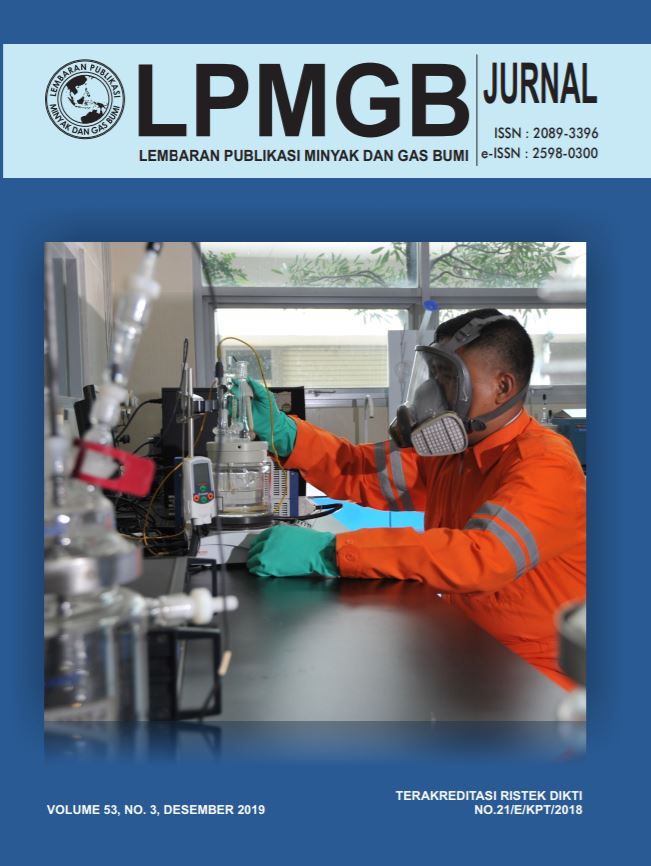PENENTUAN SWELLING FACTOR DAN TEKANAN TERCAMPUR MINIMUM UNTUK PENERAPAN INJEKSI GAS KARBONDIOKSIDA DI LAPANGAN MINYAK
DOI:
https://doi.org/10.29017/LPMGB.53.3.435Kata Kunci:
Tekanan Tercampur Minimum, Karbondioksida (CO2 ), Slimtube, Sweeling FactorAbstrak
Pengembangan (swelling) minyak dan tekanan tercampur minimum (TTM) merupakan dua faktor yang penting dari mekanisme pendesakan gas karbondioksida (CO2 ) yang terjadi di reservoir untuk penerapan injeksi CO2 di lapangan dalam upaya meningkatkan perolehan minyak tahap lanjut. Dalam paper ini penentuan swelling factor dilakukan menggunakan PVT cell, dimana fluida rekombinasi diinjeksikan dan dikondisikan pada temperatur reservoir. Sedangkan penentuan TTM antara sampel minyak dengan gas CO2 dilakukan menggunakan tiga cara, yaitu persamaan empiris, secara korelasi dan percobaan laboratorium menggunakan Slimtube. Berdasarkan hasil analisa swelling test selama proses injeksi gas CO2 sampai 46,82% mol, tekanan gelembung meningkat secara bertahap dari 410 psig sampai 2200 psig dan faktor swelling meningkat dari 1.0 sampai 1.442. Penentuan TTM menggunakan persamaan empiris (2807 Psig) dan korelasi Holm & Yosendal (2750 Psig) adalah yang paling mendekati dengan hasil penentuan dari analisa laboratorium (2800 Psig). Didasarkan pada besarnya tekanan rekah formasi di Lapisan F sebesar 2200 Psig dan TTM sebesar 2800 Psig, maka dalam penerapannya di lapangan injeksi gas CO2 hanya dapat dilakukan secara pendesakan tak tercampur.Referensi
Abdassah, D., Siregar, S. & Kristanto, D., 2000. The Potential of Carbon Dioxide Gas Injection Application in Improving Oil Recovery. Beijing, China, Society of Petroleum Engineers.
Abdurrahman, M., Permadi , A., Bae, W. & Masduki, A., 2017. EOR in Indonesia: past, present, and future. International Journal of Oil, Gas and Coal Technology, 16(3), pp. 250-270.
Barclay, T. H. & Mishra , S., 2016. New correlations for CO2-Oil solubility and viscosity reduction for light oils. Journal of Petroleum Exploration and Production Technology, Volume 6, p. 815–823.
Chae, K.-S. & Lee, J.-w., 2015. Risk analysis and simulation for geologic storage of CO2. Incheon, Korea, ACEM15.
Emera, M. & Sarma, H., 2006. A genetic algorithmbased model to predict CO2-oil physical properties for dead-live oil. Calgary, Alberta, Petroleum Society of Canada.
Holm, L. & Josendal, V., 1974. Mechanisms of oil displacement by carbondioxide. Journal of Petroleum Technology, December.26(12).
Klins, M., 1984. arbondioxide flooding: Basic mechanisms and project design. Boston, USA: Reidel Publishing Company.
LPPM UPN “Veteran†Yogyakarta, 2011. Feasibility study of CO2 flooding in Lapangan Jatibarang, Pertamina EP Region Jawa, Yogyakarta: LPPM UPN “Veteran†Yogyakarta.
Miller , J. S. & Jones , R. A., 1981. A laboratory study to determine physical characteristics of heavy oil after CO2 saturation. . Tulsa, Oklahoma, Society of Petroleum Engineers.
Mungan, N., 1981. Carbon dioxide displacement fundamentals. Journal of Canadian Petroleum Technology, 20(01).
Muslim, A., Bae , W., Permadi, A.K., Am, S., Gunadi, B., Saputra, D.S.M., Widyaningsih, R., & Gunadi, TA., 2013. Opportunities and challenges of CO2 flooding implementation in Indonesia. Jakarta, Indonesia, Society of Petroleum Engineers.
Rostami, A., Arabloo, M., Kamari, A. & Mohammadi, A. H., 2017. Modeling of CO2 solubility in crude oil during carbon dioxide enhanced oil recovery using gene expression programming. Fuel, 15
December, Volume 210, pp. 768-782.
Simon, R. & Graue, D., 1965. Generalized correlation for predicting solubility swelling and behaviour CO2-Crude oil system. Journal of Petroleum Technology, January.17(01).
Sohrabi, M. & Emadi, A., 2012. Novel Insights into the Pore-Scale Mechanisms of Enhanced Oil Recovery by CO2 Injection.. Copenhagen, Denmark, Society of Petroleum Engineers.
Stalkup, F. I., 1983. Miscible Displacement. Monograph Series. Dallas, Texas: Society of Petroleum Engineers.
Suarsana, I. P., 2010. Producing high CO2 gas content reservoirs in Pertamina Indonesia using multi stage cryogenic process. Brisbane, Queensland, Australia, Society of Petroleum Engineers.
Taber, J., Martin, F. & Seright, R., 1997. EOR screening criteria revisited-Part 1: Introduction to screening criteria and enhanced oil recovery field projects.. SPE Reservoir Engineering, 12(03).
Wellker, J. & Dunlop, D., 1963. Physical properties of carbonate oil.. Society of Petroleum Engineers of AIME.
Yellig, W. F., 1982. Carbon dioxide displacement of West Texas reservoir oil. Society of Petroleum Engineers Journal, 22(06).
Yellig, W. & Metcalfe, R., 1980. Determination and prediction of CO2 minimum miscibility pressure. Journal of Petroleum Technology, 32(01).











